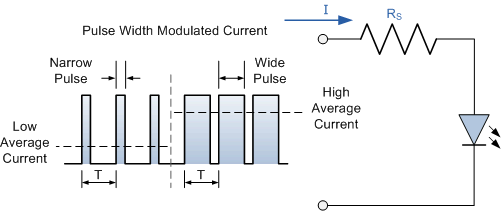LED Light Intensity using PWM

When higher light outputs are needed, a pulse width modulated current with a short duty cycle ("ON-OFF" Ratio) allows the diode current and thus the output light intensity t o be increased considerably during actual pulses, while still keeping the LEDs "average current level" and power dissipation within the safe limits. This "ON-OFF" flashing condition dosen't affect what is seen as the human eyes fills in the gaps in between the "ON" and "OFF" light pulses, providing the pulse frequency is sufficiently high, making it appear as a continuous light output. So pulses at the frequency of 100Hz or more actually appear brighter to eye than a continuous light of same average intensity.
Email based Electronics Devices and circuits assignment help - homework help at Expertsmind
Are you searching Electronics Engineering assignment help expert for help with LED Light Intensity using PWM questions? LED Light Intensity using PWM topic is not easier to learn without any external help? We at www.expertsmind.com offers free lecture notes for Electronics Devices and circuits assignment help and Electronics Devices and circuits homework help. Live tutors are available 24x7 hours for helping students in their LED Light Intensity using PWM related problems. We provide step by step LED Light Intensity using PWM question's answers with 100% plagiarism free content. We prepare quality content and notes for LED Light Intensity using PWM topic under Electronics Devices and circuits theory and study material. These are avail for subscribed users and they can get advantages anytime.
Why Expertsmind for assignment help
- Higher degree holder and experienced experts network
- Punctuality and responsibility of work
- Quality solution with 100% plagiarism free answers
- Time on Delivery
- Privacy of information and details
- Excellence in solving electronics engineering questions in excels and word format.
- Best tutoring assistance 24x7 hours